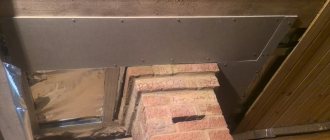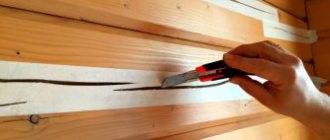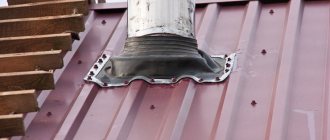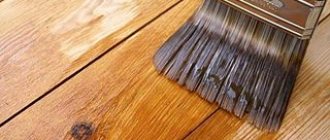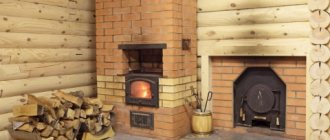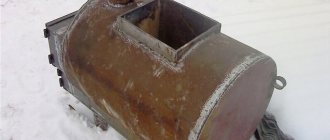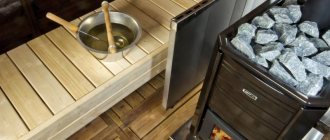If the house has a stove or fireplace, then the tightness and cleanliness of the chimney becomes a constant concern. Not only the fire safety of the building during the heating season depends on the integrity of the smoke exhaust pipe. Heat-resistant chimney sealant will save you money that will “fly into a leaky chimney” due to increased fuel consumption, forced repairs or even replacement of the smoke exhaust duct.
Why do you need chimney sealing?
Settlement of the foundation of a stove or building, systematic temperature changes (t°) during the operation of stove heating, and random mechanical impacts can lead to cracks and fistulas in the chimney. Loss of tightness can cause a number of serious problems with safety and the very possibility of further operation of the heating system as a whole.
Note! According to statistics, the vast majority of fires and deaths from carbon monoxide are associated with malfunctioning chimneys.
Sealing the chimney is necessary to avoid various problems that can not only impair the performance of the chimney itself, but also threaten the life and health of the inhabitants of the house:
- Cracks in the pipe lead to a loss of traction force, which leads to an increase in fuel consumption.
- Burnouts cause fires because the temperature of the pipe increases sharply where it passes through the roof, attic or interfloor ceiling.
- Air leaks from the outside cause the formation of a large amount of internal condensation on the walls of the chimney. This leads to its rapid destruction, regardless of the type of channel. In a steel sandwich pipe, condensate is a powerful catalyst for metal corrosion. In a brick chimney it destroys the masonry.
- Through cracks, toxic combustion products enter the room.
The tightness of the chimney is the main task when installing a heating system. In order for this problem to be solved efficiently and for a long time, you should be well versed in the variety of heat-resistant sealants on the modern market.
Why insulate the seams of a steam room
Insulating the walls of a bathhouse or sauna helps maintain the necessary microclimate of the room, reduce heat loss and create suitable temperature conditions for the steam room. If the seams are not sealed properly, this increases fuel consumption, increases heat loss from the structure and leads to leakage and the appearance of mold and putrefactive processes. Insulating the seams helps create tightness and the conditions necessary for the normal functioning of the bathhouse and steam room. For this purpose, various methods are used, in particular, caulk and sealants.
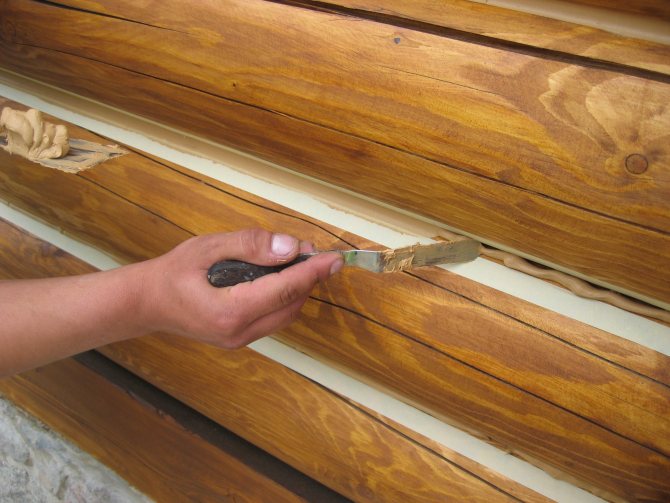
What means are used to create a tight connection?
Special polymer-based compounds have been developed for sealing chimneys, stoves and fireplace inserts. Temperature sealants have a gel-like, fluid consistency, which allows them to flow into the smallest cavities, joints, and cracks. They differ in composition and have different operating temperature limits. Most are produced in special cylinders compatible with the mounting gun.
Note! The uniqueness of sealing compounds for furnaces is that, in addition to their resistance to high temperatures, they are not destroyed by repeated, significant changes in temperature - from -60 to +250 and above.
Sealants for heating systems differ in several parameters:
- according to the constituent components - there are two and one component;
- according to acidity level – acidic and neutral;
- in relation to temperature effects - divided into heat-resistant (low-temperature) and heat-resistant (high-temperature);
- by consistency - gels, pastes.
We recommend that you read: How to make a shed from a profile with your own hands
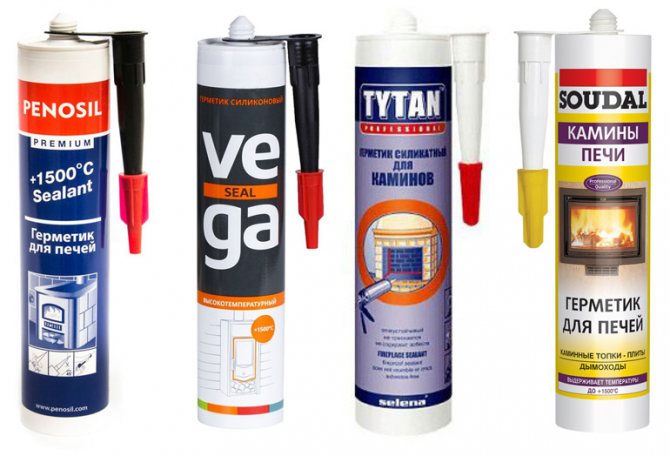
Single-component formulations are sold in one bottle. They are ready to use and do not require additional preparation. These insulating compounds are popular among craftsmen. Their use does not require specific knowledge or skills. When applied to a surface, they harden at room temperature for a certain time.
Two-component heat-resistant sealants consist of two substances, each of which is placed in a separate container. The basis is a polymer; the addition is a catalyst that promotes the solidification of this polymer. Before use, a two-component insulator is prepared by mixing the ingredients. Violation of the proportions or technology of preparing the mixture leads to loss of sealing qualities. The finished mixture has virtually no shelf life. It should be used for a short period of time.
Note! Difficulties in preparing two-component compositions for work lead to the fact that non-specialists do not risk using them. Such sealants are used by professional stove makers and builders.
Heat-resistant compositions include those whose upper limit is limited to 150-250 degrees. They are intended for the external walls of stoves, fireplaces, and brick chimneys.
Heat-resistant or high-temperature sealants are called sealants, the resistance of which reaches a value of 1500 degrees. These compounds can be used not only for the inside of steel pipes, but also in open fire zones - to seal seams and burnouts in a fireplace or stove insert.
Note! A special group consists of polymer adhesives and sealants of the MS brand. These are high-strength polyurethane compounds that can withstand temperatures up to 200 degrees, do not collapse under the influence of ultraviolet radiation, atmospheric influences, retain elasticity, and have increased adhesion to the surfaces being connected.
Polymer adhesives-sealants are rapidly gaining popularity in the construction, industrial (including machine-building) segment of European countries.
In everyday life, for gas and electric stoves, adhesive-sealant type Dow Corning Q3 - 1566 is used.
We recommend that you familiarize yourself with: SML pipe and socketless cast iron sewerage
Features of heat-resistant sealants
Heat-resistant or low-temperature sealants are produced on a silicone basis. Their scope of application is limited to the external surfaces of stoves, fireplaces and brick chimneys. For application inside, these products are not heat-resistant enough, and for steel pipes they are aggressive because they have an acidic component.
The peculiarity of their use is also in the thickness of the layer applied. For each product, the manufacturer indicates the optimal application thickness. Don't neglect these recommendations to get a reliable connection.
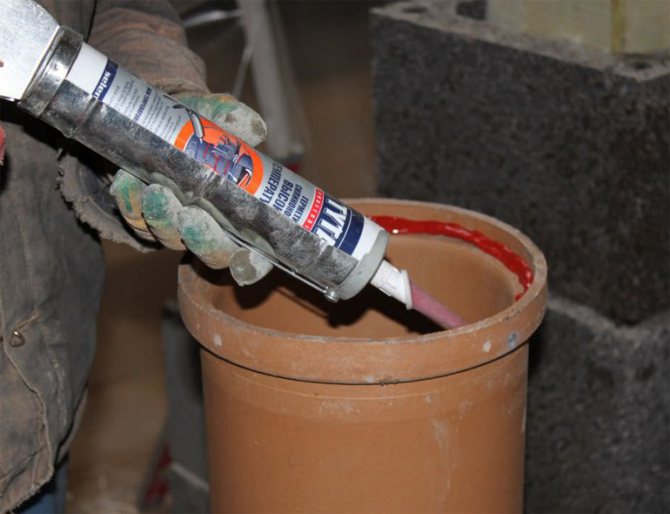
Note! To harden, the heat-resistant insulator uses moisture from the surrounding air. With an increased thickness of the applied product, its inner layers will not be able to harden sufficiently.
Distinctive qualities of heat-resistant sealants for chimneys:
- The silicone base contains iron oxide, which gives the product a brown color.
- When applied, there is often a vinegar smell as the acid base evaporates.
- Neutral low-temperature insulators release alcohol and water when they harden, rather than acid. Such products can be used to insulate iron elements of chimneys or roofs. An example of such an insulator is PENOSIL Premium High Temp Sealant from the international brand Wolf Group.
- Silicone chimney sealants have good adhesion to different surfaces. They adhere equally well to mortar, brick, ceramics, glass, and soft roofing materials.
- Maintaining high elasticity during hardening makes it possible to maintain the tightness of connections during thermal expansion-compression of materials, under vibration loads of open segments of the chimney.
Moisture resistance and ultraviolet resistance make these materials indispensable for sealing the external elements of the chimney and roof penetration.
Note! It is not advisable to use low-temperature sealants to seal deep chimney cracks. There, the layer thickness will exceed the recommended parameters, not allowing the inner layers to harden sufficiently.
Low-temperature insulators have proven themselves well among motorists. However, when choosing a car repair product, you should pay attention to the acidity level of the paste. Belife Silicone sealants have proven themselves to be excellent for metal elements.
We recommend that you read: How to make a chimney passage through a metal roof with your own hands
What sealant to use
In this case, universal silicone or polyurethane compounds are not suitable for insulating wooden baths. Such sealants cannot withstand sudden temperature changes and release harmful substances when heated. To insulate paired seams, heat-resistant wood sealants, acrylic and thiokol, should be used. Such tools are intended for external and internal work and cope with the assigned tasks to the maximum extent possible.
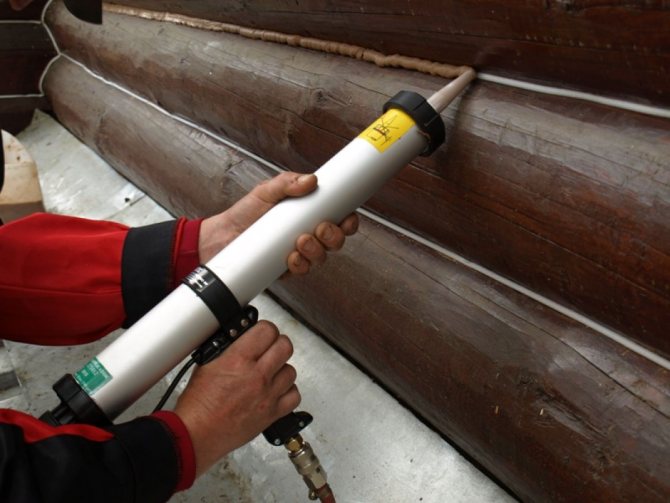
Distinctive properties of high-temperature sealants from heat-resistant ones
High-temperature sealing compounds are produced on a silicate (mineral) basis. Silex translated from Latin means stone. Hence the exceptional resistance of these products to significant temperatures, up to a temperature of 1500 °C.
The main difference between heat-resistant sealants and simply heat-resistant ones is their application. If low-temperature insulators are used for external seams, then heat-resistant ones are not limited in location. They can reliably insulate the inner surface of the seams of the refractory masonry of the furnace or fireplace, the inside of the smoke exhaust ducts, where temperature values reach a maximum.
Note! Sealants of this class are labeled as fire-resistant. Their color varies from gray to black.
Features of using heat-resistant insulators:
- Unlike heat-resistant sealants, fire-resistant sealants have weak adhesion to surfaces. In order for the material to be sufficiently fixed, the surface must first be degreased and sanded, giving it the necessary roughness.
- These products have less elasticity when cured, unlike silicone insulators. Avoid applying them to surfaces that are subject to mechanical stress or vibration.
- You can work with heat-resistant insulators only at positive ambient temperatures (from 5 to 40 degrees).
Application rules
To ensure that the tightness of the connection does not cause any complaints, it is important to follow some rules when applying sealant:
- The area where the sealant is applied is cleaned of dust and degreased. For silicone products, the application site should be thoroughly dried. For fireproof ones, moisten with water.
- You should work with gloves, avoiding contact of the product with your skin. If this happens, you should rinse the skin with plenty of water.
- For complete hardening of the insulators, you should wait 24 hours with the first firebox.
- It is necessary to conduct a test fire to check the sealing and final fastening of the sealing materials.
- You should start working with any composition only after carefully studying the manufacturer’s recommendations.
How to insulate seams using sealant
To make insulation as effective as possible, you must adhere to the following recommendations:
- The sealant is applied with a construction gun;
- Work should be carried out in dry and warm weather conditions;
- It is not advisable to insulate the seams immediately after the construction of the log house. It is necessary to wait at least 4-6 months for the structure to shrink and wood to acclimatize;
- Before starting work, the seams are thoroughly cleaned of dirt and dust;
- In especially deep seams, you should first lay a special polyethylene cord, which will improve the adhesion of the composition to the surface and provide additional sealing;
- After the work is completed, the remaining glue is removed and the seams are smoothed with a spatula.
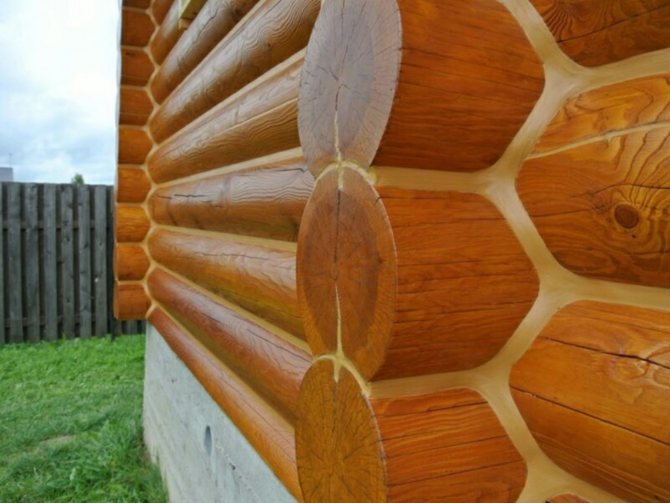
High-quality insulation of a log bathhouse is the key to its long and proper functioning, as well as reducing the cost of heating the room.
